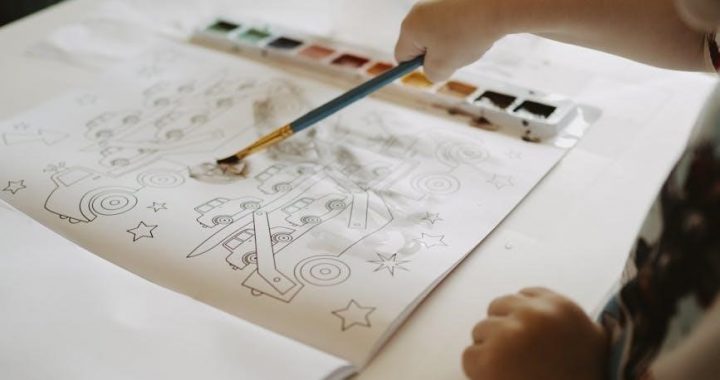Welcome to the world of watercolor painting, a versatile and expressive medium perfect for artists of all skill levels. This guide provides a comprehensive introduction, helping you master the fundamentals, explore techniques, and unlock your creative potential through step-by-step tutorials and expert recommendations.
Why Start with Watercolor?
Watercolor painting offers a unique combination of versatility and accessibility, making it an excellent choice for both beginners and seasoned artists. Its fluidity and transparency allow for ethereal effects that captivate the eye. The medium’s forgiving nature encourages experimentation and organic results. Additionally, watercolor is highly portable, perfect for urban sketching and on-the-go creativity. With countless tutorials and guidebooks available, mastering watercolor has never been more achievable or enjoyable.
Key Benefits of Learning Watercolor
Learning watercolor painting enhances creativity, patience, and observation skills. It fosters a deeper connection with art and nature. The medium’s unpredictability teaches adaptability and spontaneity. Watercolor also offers therapeutic benefits, reducing stress through its meditative process. As you progress, you’ll gain confidence in your artistic abilities, unlocking new ways to express yourself visually. These skills are invaluable for personal growth and artistic exploration.
Choosing the Right Supplies
Selecting quality watercolor tools is essential for optimal results. Invest in durable brushes, vibrant paints, and sturdy paper to enhance your creative process and artwork quality effectively.
Essential Tools for Beginners
Start with high-quality watercolor brushes in various sizes, round and flat, to achieve different effects. Use cold-pressed paper for optimal texture and blending. Choose vibrant, light-fast paints for lasting color. A sturdy palette with built-in wells helps organize your colors. Invest in a water container, masking tape for borders, and a pencil for sketching. These basics will set you up for success in your watercolor journey.
Understanding Watercolor Brushes and Paints
Watercolor brushes come in natural or synthetic fibers, with natural hair like sable offering exceptional water-holding capacity. Round brushes are ideal for details, while flat brushes are perfect for broad washes. Paints are available in pans or tubes, with student-grade options being cost-effective and professional-grade offering higher pigment loads for vibrant colors. Understanding these tools is key to mastering watercolor techniques and achieving desired effects in your artwork.
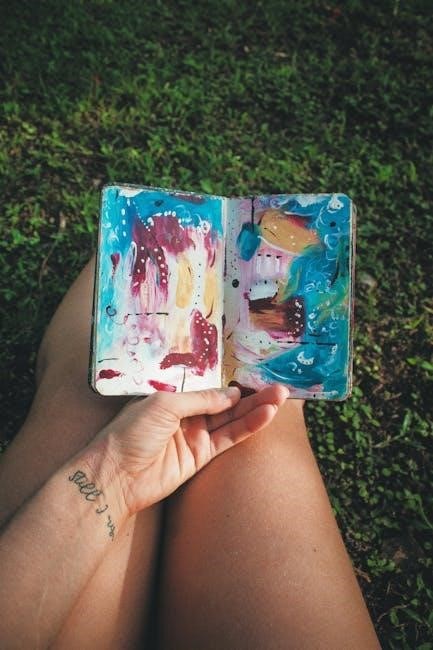
Basic Watercolor Techniques
Master essential methods like wet-on-wet and wet-on-dry to achieve vibrant, layered effects. Practice blending and washes to build confidence in your artistic expression.
Mastering Wet-on-Wet and Wet-on-Dry Methods
Wet-on-wet involves applying pigment to damp paper for soft blends and fluid transitions, ideal for skies and backgrounds. Wet-on-dry requires a dry surface, offering crisp edges and detailed work. Both techniques are foundational for watercolor success, allowing artists to control texture and color intensity with precision and creativity in their paintings.
Step-by-Step Tutorials for Beginners
Step-by-step tutorials are essential for mastering watercolor basics. Start with simple exercises like washing techniques and color mixing. Practice painting basic shapes and gradients to build confidence. Follow guided lessons to learn how to layer and blend colors effectively; These tutorials provide clear instructions, helping you understand the fundamentals and gradually improve your skills through hands-on practice and creative exploration.
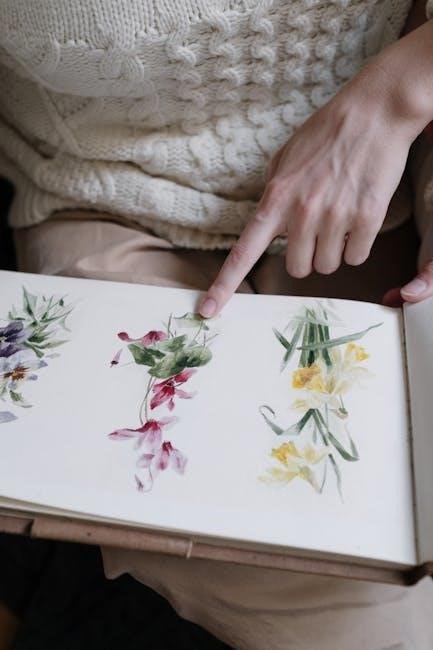
Color Theory and Palette Building
Understanding color theory is key to creating vibrant, harmonious watercolor paintings. Learn how to mix colors, balance warm and cool tones, and build a cohesive palette for stunning results.
Foundations of Color Harmony
Mastering color harmony is essential for creating visually appealing watercolor art. Start by understanding the color wheel, primary and secondary colors, and how they interact. Learn about warm and cool tones, complementary colors, and the 60-30-10 rule for balanced compositions. These principles will guide you in mixing vibrant hues and creating cohesive, professional-looking paintings that captivate the eye. Experimentation is key to finding your unique style and palette.
Creating a Balanced Color Palette
A balanced color palette is achieved by selecting hues that work harmoniously together. Consider the 60-30-10 rule: 60% dominant color, 30% secondary, and 10% accent. Experiment with warm and cool tones to evoke mood and depth. Test color combinations on paper before painting. Remember, consistency and contrast create visual interest. Practice mixing colors to find your unique style and ensure harmony in your watercolor pieces.
Exploring Different Styles and Approaches
Discover the versatility of watercolor by experimenting with loose, detailed, and urban sketching styles. Each approach offers unique artistic expression, from spontaneous wet-on-wet techniques to meticulous ink-and-wash methods. Start with loose styles for freedom, then refine with detail. Find inspiration in nature, architecture, and everyday scenes. Practice various techniques and study master artists to expand your creative horizons.

Loose vs. Detailed Painting Styles
Loose watercolor styles emphasize spontaneity and fluidity, often using wet-on-wet techniques to create soft, blended effects. Detailed styles, in contrast, focus on precision and control, typically employing wet-on-dry methods for crisp lines and intricate details. Loose painting is ideal for capturing movement and natural scenes, while detailed work suits realism or intricate compositions. Experiment with both to discover your artistic voice and preference.
Urban Sketching with Watercolor
Urban sketching with watercolor combines observation and creativity to capture city life. Use loose strokes and vivid washes to depict buildings, streets, and people; This approach blends spontaneity with precision, perfect for documenting travels or daily scenes. Watercolor’s portability makes it ideal for on-location work, allowing you to quickly sketch and paint dynamic urban environments with fresh, expressive results.
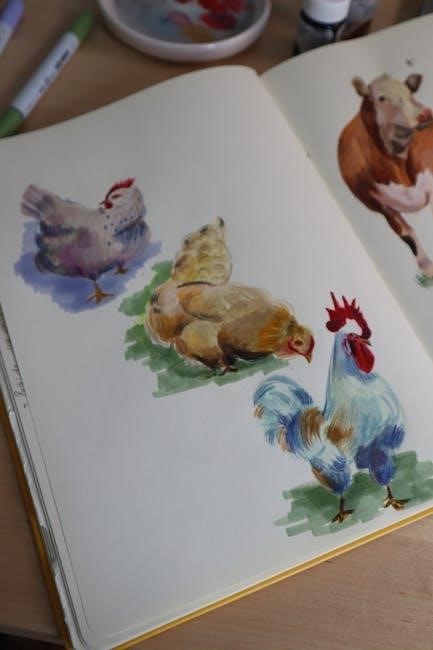
Common Mistakes and How to Avoid Them
Beginners often overuse water, causing muddy colors, and neglect proper brush care. Avoid thick washes and overmixing by using light layers and testing colors on separate paper first.
Understanding Common Errors in Watercolor
Common mistakes in watercolor include over-saturating the brush, leading to unintended bleeds, and applying too much pigment, which results in muddy colors. Mixing too many layers can also cause the painting to lose its transparency. Additionally, neglecting to plan the composition beforehand often leads to imbalance. Recognizing these errors early helps in refining techniques and achieving desired results. Proper brush care and testing colors on separate paper are essential practices to avoid such issues. By understanding these pitfalls, artists can take corrective measures to enhance their work and maintain the delicate beauty of watercolor art. This section will guide you through identifying these errors and how to prevent them, ensuring a smoother creative process and more satisfying outcomes. Learning to correct mistakes is a crucial part of mastering watercolor painting, and with practice, these common issues can be easily avoided. The key is to approach each piece with patience and attention to detail, allowing for growth and improvement with each project. This understanding will help you develop a stronger foundation in watercolor techniques and elevate your artistic expression.
Tips for Correcting Mistakes
Correcting mistakes in watercolor requires patience and quick action. Lift excess pigment with a damp brush or blot gently with a clean cloth. For stubborn errors, masking fluid can protect areas while reworking. Layering transparent washes can also revive overworked sections. Practice on scrap paper to refine techniques before applying them to your final piece. These tips help restore balance and beauty to your artwork.
Inspiration and Motivation
Discover inspiration in nature, art, and everyday moments. Watercolor tutorial books like “Everyday Watercolor” and “The Joy of Watercolor” offer step-by-step guides and stunning examples to spark creativity and keep you motivated throughout your artistic journey.
Finding Inspiration for Your Art
Finding inspiration for watercolor art begins with exploring nature, urban scenes, and personal experiences. Books like Everyday Watercolor and The Joy of Watercolor offer stunning examples and step-by-step guides to spark creativity. Plan your scenes, experiment with colors, and draw from life to stay inspired. Urban sketching and loose painting styles can also motivate you to capture the world around you in unique ways.
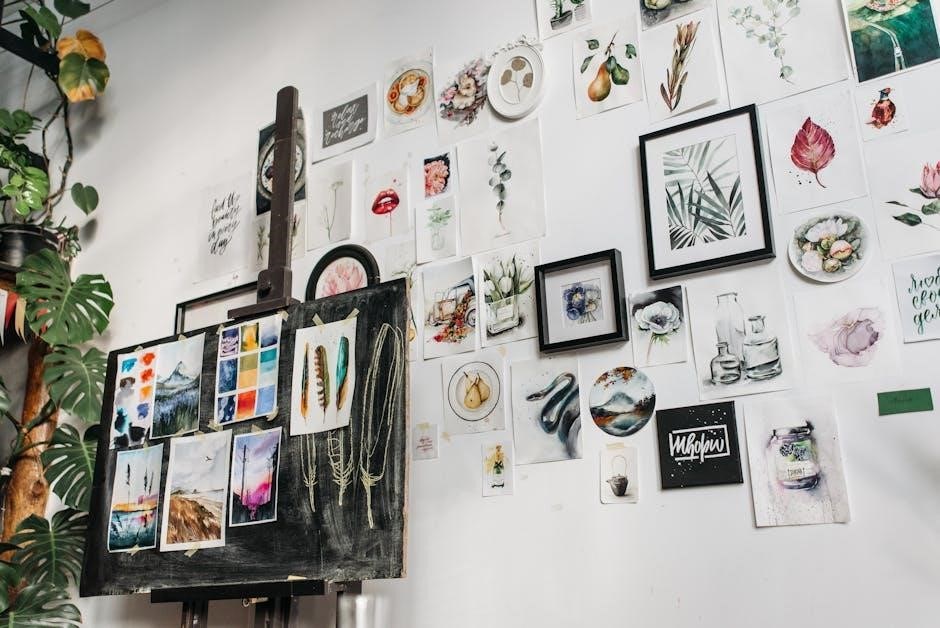
Staying Motivated Throughout Your Journey
Staying motivated in watercolor painting involves setting achievable goals, practicing regularly, and celebrating progress. Embrace challenges as learning opportunities and experiment freely. Join online communities, follow inspiring artists, and use tutorials or eBooks for guidance. Remember, every stroke brings you closer to mastery. Keep a growth mindset, enjoy the process, and let your passion for watercolor shine in every piece you create.
Advanced Techniques and Projects
Explore advanced watercolor techniques and tackle challenging projects to refine your skills. From intricate details to large-scale works, push your artistic boundaries with full confidence.
Exploring Complex Techniques
Discover advanced watercolor methods like wet-on-wet, wet-on-dry, glazing, and negative painting. These techniques allow for intricate details and layered effects, enhancing your artistic expression. Practice blending colors seamlessly and achieving vibrant, luminous washes. Experiment with unconventional tools and surfaces to expand your creative horizons. Mastering these skills will elevate your work and open doors to more sophisticated projects and styles in watercolor painting.
Challenging Projects to Test Your Skills
Push your abilities with intricate projects like capturing dynamic skies, detailed botanicals, or layered cityscapes. Practice advanced techniques such as glazing, negative painting, and subtle color transitions. Tackle complex compositions with multiple washes and precise brushwork. These challenges will refine your control and confidence, helping you achieve professional-level results in your watercolor journey. Use these exercises to explore new creative boundaries and master advanced methods.
Celebrate your progress and embrace the joy of watercolor painting. Set future goals, explore new techniques, and continue refining your skills. Happy creating!
Summarizing Your Learning Journey
Your watercolor journey has been a path of discovery, from mastering basic techniques to exploring advanced methods. You’ve learned to balance color theory, experiment with styles, and correct mistakes. This comprehensive approach has equipped you with the confidence to create stunning pieces. Reflecting on your progress, you’ve gained not only skills but also a deeper appreciation for the medium’s versatility and beauty.
Setting Future Goals in Watercolor Painting
As you progress, set achievable goals to refine your skills and explore new creative horizons. Aim to master complex techniques, experiment with diverse styles, and tackle challenging projects. Regular practice and exploring inspiration will keep you motivated. Consider setting specific objectives, like completing a series of pieces or learning from advanced tutorials, to continue growing as a watercolor artist and enjoying the journey.
